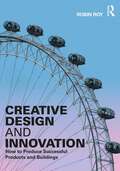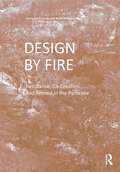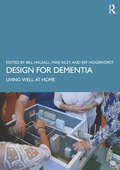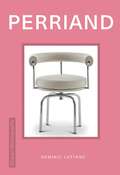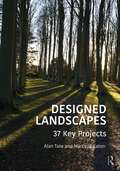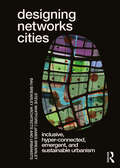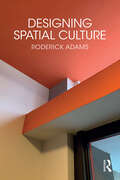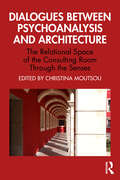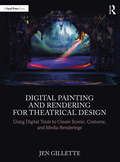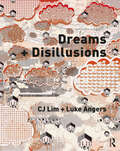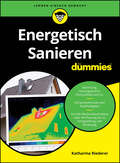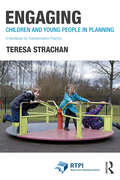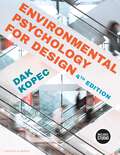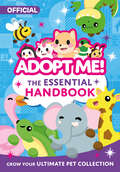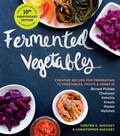- Table View
- List View
Creative Design and Innovation: How to Produce Successful Products and Buildings
by Robin RoyUsing many real-world examples and cases, this book identifies key factors and processes that have contributed to the creation of successful new products, buildings, and innovations, or resulted in some failures. Such factors include the creativity of individuals and groups, their sources of inspiration, the processes of creative design and innovation, and the characteristics of the products, buildings, and innovations themselves. Much has been written about creativity and innovation, but what helps to foster creativity, enable creative ideas to be translated into practical designs, and ensure those new products or buildings succeed as innovations on the market or in use? This book discusses these elements through the author’s origination and analysis of examples and case studies ranging from the revolutionary innovation of the smartphone, through radical innovations in domestic appliances and sustainable housing, to creative designs of contemporary jewellery. The broad range of examples and cases include product and fashion design, filmmaking and fine art, as well as industrial design, engineering, and architecture, offering lessons for creatives, designers, and innovators from many subject backgrounds. Analysis of the different factors, successes, and failures are presented in text boxes throughout the book to allow readers to easily understand the key lessons from each example or case, with numerous colour visuals, diagrams, and charts for illustration. This book is a must-read for a broad audience interested in creativity, design, and innovation, including practitioners in design, engineering, architecture, and product management, and students and instructors of those subjects.
Creative Design and Innovation: How to Produce Successful Products and Buildings
by Robin RoyUsing many real-world examples and cases, this book identifies key factors and processes that have contributed to the creation of successful new products, buildings, and innovations, or resulted in some failures. Such factors include the creativity of individuals and groups, their sources of inspiration, the processes of creative design and innovation, and the characteristics of the products, buildings, and innovations themselves. Much has been written about creativity and innovation, but what helps to foster creativity, enable creative ideas to be translated into practical designs, and ensure those new products or buildings succeed as innovations on the market or in use? This book discusses these elements through the author’s origination and analysis of examples and case studies ranging from the revolutionary innovation of the smartphone, through radical innovations in domestic appliances and sustainable housing, to creative designs of contemporary jewellery. The broad range of examples and cases include product and fashion design, filmmaking and fine art, as well as industrial design, engineering, and architecture, offering lessons for creatives, designers, and innovators from many subject backgrounds. Analysis of the different factors, successes, and failures are presented in text boxes throughout the book to allow readers to easily understand the key lessons from each example or case, with numerous colour visuals, diagrams, and charts for illustration. This book is a must-read for a broad audience interested in creativity, design, and innovation, including practitioners in design, engineering, architecture, and product management, and students and instructors of those subjects.
Design by Fire: Resistance, Co-Creation and Retreat in the Pyrocene
by Emily Schlickman Brett MilliganAcross the world, the risks of wildfires are increasing and expanding. Due to past and current human actions, we dwell in the age of fire – the Pyrocene – and the many challenges and climate adaptation questions it provokes. Exploring our past and current relationships with fire, this book speculates on the pyro futures yet to be designed and cared for.Drawing upon fieldwork, mapping, drone imagery, and interviews, this publication curates 27 global design case studies within the vulnerable and dynamic wildland-urban interface and its adjacent wildlands. The book catalogs these examples into three approaches: those that resist the creative and transformative power of fire and forces of landscape change, those that embrace and utilize those forces, and those that intentionally try to retreat and minimize human intervention in fire-prone landscapes. Rather than serving as a book of neatly packaged solutions, it is a book of techniques to be considered, tested, and evaluated in a time of fire.
Design by Fire: Resistance, Co-Creation and Retreat in the Pyrocene
by Emily Schlickman Brett MilliganAcross the world, the risks of wildfires are increasing and expanding. Due to past and current human actions, we dwell in the age of fire – the Pyrocene – and the many challenges and climate adaptation questions it provokes. Exploring our past and current relationships with fire, this book speculates on the pyro futures yet to be designed and cared for.Drawing upon fieldwork, mapping, drone imagery, and interviews, this publication curates 27 global design case studies within the vulnerable and dynamic wildland-urban interface and its adjacent wildlands. The book catalogs these examples into three approaches: those that resist the creative and transformative power of fire and forces of landscape change, those that embrace and utilize those forces, and those that intentionally try to retreat and minimize human intervention in fire-prone landscapes. Rather than serving as a book of neatly packaged solutions, it is a book of techniques to be considered, tested, and evaluated in a time of fire.
Design for Dementia: Living Well at Home
by Bill Halsall Michael Riley Eef HogervorstDesign for Dementia is written by an interdisciplinary team of professionals and academics whose aim is to present lessons learnt from the Dementia Demonstration House at the Building Research Establishment’s Innovation Park. Known as Chris and Sally’s House, the project represents a unique opportunity to show in practice what can be done to assist people living with dementia to continue to live at home and as part of the community with as much independence as possible. This book presents evidence based practical design guidance backed up by over 15 combined years of research by experienced professional designers.Beginning with an introduction which provides the background to the global dementia epidemic to allow readers to gain a better understanding of the issues they must consider, the book then discusses how good design principles, planning and construction standards can be used to effectively respond to the dementia crisis. The detailed findings from research using Chris and Sally’s House are presented and discussed, along with practical examples and success stories ranging from simple design features to the more complex use of sensors and automated ventilation.The hope is that readers can apply the lessons learnt from Chris and Sally’s House to successfully integrate solutions into the design of new or refurbished housing for the elderly and also that the tools and insights shared will inform the wider context of good housing design, as well as the spectrum of constraints and design standards which often apply. This book is important reading for architects, designers, engineers and project managers, but also anyone with an interest in learning about practical solutions to aid those with dementia to live well at home.
Design for Dementia: Living Well at Home
by Bill Halsall Michael Riley Eef HogervorstDesign for Dementia is written by an interdisciplinary team of professionals and academics whose aim is to present lessons learnt from the Dementia Demonstration House at the Building Research Establishment’s Innovation Park. Known as Chris and Sally’s House, the project represents a unique opportunity to show in practice what can be done to assist people living with dementia to continue to live at home and as part of the community with as much independence as possible. This book presents evidence based practical design guidance backed up by over 15 combined years of research by experienced professional designers.Beginning with an introduction which provides the background to the global dementia epidemic to allow readers to gain a better understanding of the issues they must consider, the book then discusses how good design principles, planning and construction standards can be used to effectively respond to the dementia crisis. The detailed findings from research using Chris and Sally’s House are presented and discussed, along with practical examples and success stories ranging from simple design features to the more complex use of sensors and automated ventilation.The hope is that readers can apply the lessons learnt from Chris and Sally’s House to successfully integrate solutions into the design of new or refurbished housing for the elderly and also that the tools and insights shared will inform the wider context of good housing design, as well as the spectrum of constraints and design standards which often apply. This book is important reading for architects, designers, engineers and project managers, but also anyone with an interest in learning about practical solutions to aid those with dementia to live well at home.
Design Monograph: Perriand
by Dominic LutyensA design monograph series on the most remarkable architects, designers, brands and design movements of the twentieth and twenty-first centuries, each book contains a historical-critical essay discussing the life and work of the subject, followed by an illustrated appreciation of groundbreaking work.French architect and designer Charlotte Perriand not only created buildings such as the League of Nations in Geneva and ski resorts but was responsible for iconic furniture pieces in tubular steel, such as the Nuage bookshelf, Grand Confort chair (while working for Le Corbusier), B301 recliner and the ponyskin Chaise Longue.
Designed Landscapes: 37 Key Projects
by Alan Tate Marcella EatonDesigned Landscapes is a case-by-case study of 37 significant, existing works of landscape design worldwide, largely constructed since the Renaissance. Being an informative and easy-to-read reference volume for practitioners and students alike, it presents key precedents in landscape architecture using site plans and recent photographs to showcase each project. Organised and presented in 12 sections based on project type, each project is examined based on date, previous site condition, designer(s), design intentions, current composition, unique features, ownership and management, and comparable projects. Each chapter offers an insightful critique of the featured projects. Written by the authors of Great City Parks, the book posits that these carefully selected key projects have maintained their status throughout the ages because they express values and design intentions that continue to inform the practice of the landscape architecture in the present day. The book concludes with a ten-point summary of lessons for professional practice gleaned from the studies. Including a wide range of case studies from countries including many in western Europe, the United States, Canada, India, Japan and China, and lavishly illustrated with over 200 full-colour images, the book is a must-have volume for anyone interested in the history and current practice of landscape architecture.
Designed Landscapes: 37 Key Projects
by Alan Tate Marcella EatonDesigned Landscapes is a case-by-case study of 37 significant, existing works of landscape design worldwide, largely constructed since the Renaissance. Being an informative and easy-to-read reference volume for practitioners and students alike, it presents key precedents in landscape architecture using site plans and recent photographs to showcase each project. Organised and presented in 12 sections based on project type, each project is examined based on date, previous site condition, designer(s), design intentions, current composition, unique features, ownership and management, and comparable projects. Each chapter offers an insightful critique of the featured projects. Written by the authors of Great City Parks, the book posits that these carefully selected key projects have maintained their status throughout the ages because they express values and design intentions that continue to inform the practice of the landscape architecture in the present day. The book concludes with a ten-point summary of lessons for professional practice gleaned from the studies. Including a wide range of case studies from countries including many in western Europe, the United States, Canada, India, Japan and China, and lavishly illustrated with over 200 full-colour images, the book is a must-have volume for anyone interested in the history and current practice of landscape architecture.
Designing Networks Cities: Inclusive, Hyper-Connected, Emergent, and Sustainable Urbanism
by Steve Whitford James Brearleydesigning networks cities presents a sophisticated, multi-disciplinary, and multi-dimensional approach to urban design. Emerging from years of practice, experimentation, and research by designers (landscape architects, urban planners, urban designers and architects), this approach engages with contemporary thought across a number of disciplines to re-invent the entrenched blunt instruments of the city making process. A cry for flexible, sharp-instruments in urban design, designing networks cities presents a multi-dimensional way of seeing the essential components of the city (form, space-time, order and aesthetics). It purposefully links traditional architectural design derivation mechanisms to urban design, in the hope that cities will not only be pragmatic, but also become sophisticated iconographically, poetically, and syntactically. It provides the tools to enable decision making within a multiplicity of constraints and opportunities: a philosophy of becoming, not being; a science of dynamic systems, not stasis; and an art of sensations, not subjectivity. And finally, and most importantly, it argues why it is important that cities embrace these multiple dimensions of society on a planet that is facing increasing environmental challenges: an economics focused on equity for all, not for some more than others; a politics supporting a genuine representational democracy, not one representing the overly influential; and a culture [including history] that embraces difference, not one that encourages division. designing networks cities not only provides the means to identify these issues and a methodology to deal with them within a complex emerging co-existence, but also demonstrates the development of cities that embrace and respond to the complexities of life in what some are calling the Anthropocene.
Designing Networks Cities: Inclusive, Hyper-Connected, Emergent, and Sustainable Urbanism
by Steve Whitford James Brearleydesigning networks cities presents a sophisticated, multi-disciplinary, and multi-dimensional approach to urban design. Emerging from years of practice, experimentation, and research by designers (landscape architects, urban planners, urban designers and architects), this approach engages with contemporary thought across a number of disciplines to re-invent the entrenched blunt instruments of the city making process. A cry for flexible, sharp-instruments in urban design, designing networks cities presents a multi-dimensional way of seeing the essential components of the city (form, space-time, order and aesthetics). It purposefully links traditional architectural design derivation mechanisms to urban design, in the hope that cities will not only be pragmatic, but also become sophisticated iconographically, poetically, and syntactically. It provides the tools to enable decision making within a multiplicity of constraints and opportunities: a philosophy of becoming, not being; a science of dynamic systems, not stasis; and an art of sensations, not subjectivity. And finally, and most importantly, it argues why it is important that cities embrace these multiple dimensions of society on a planet that is facing increasing environmental challenges: an economics focused on equity for all, not for some more than others; a politics supporting a genuine representational democracy, not one representing the overly influential; and a culture [including history] that embraces difference, not one that encourages division. designing networks cities not only provides the means to identify these issues and a methodology to deal with them within a complex emerging co-existence, but also demonstrates the development of cities that embrace and respond to the complexities of life in what some are calling the Anthropocene.
Designing Spatial Culture
by Roderick AdamsDesigning Spatial Culture investigates a powerful experiential dialogue formed between the habitation of space and a diversified cultural realm. This creative proposition binds and positions human activity and experience framing its histories, currency and future. Whilst the book distinguishes between the conditions of the existing urban/ architecture/ interior canon, it embraces a new agency of space, showcasing the encounters, assemblies and designs that shape human behaviours and the cultural forms of the built environment. Using authoritative case studies, the book examines many locations and spaces, ranging from new urban landscapes, historical domestic spaces and contemporary architecture. It embraces the most lavish and flamboyant to the most simplistic and minimal, establishing a connected cultural narrative. The book shifts the focus in the spatial realm from an object-based experience (where space is filled with things) to a more complete immersive experience (combining physical and digital). A key part of this exploration is the relationship between the architecture and the interior which is often the most predominant spatial experience and fundamental to the understanding spatial experience and existing cultures. Without the architectural enclosure, the interior would lose its site context and structure for its existence. Without an interior, architecture would not fully develop an engaging spatial experience for the user. The book rationalises this through extended use of a spatial probe which documents and summarises an evidence-based research project capturing spatial culture data from a predominantly domestic setting. The book is essential reading for students and researchers in architecture, interior design and urban design.
Designing Spatial Culture
by Roderick AdamsDesigning Spatial Culture investigates a powerful experiential dialogue formed between the habitation of space and a diversified cultural realm. This creative proposition binds and positions human activity and experience framing its histories, currency and future. Whilst the book distinguishes between the conditions of the existing urban/ architecture/ interior canon, it embraces a new agency of space, showcasing the encounters, assemblies and designs that shape human behaviours and the cultural forms of the built environment. Using authoritative case studies, the book examines many locations and spaces, ranging from new urban landscapes, historical domestic spaces and contemporary architecture. It embraces the most lavish and flamboyant to the most simplistic and minimal, establishing a connected cultural narrative. The book shifts the focus in the spatial realm from an object-based experience (where space is filled with things) to a more complete immersive experience (combining physical and digital). A key part of this exploration is the relationship between the architecture and the interior which is often the most predominant spatial experience and fundamental to the understanding spatial experience and existing cultures. Without the architectural enclosure, the interior would lose its site context and structure for its existence. Without an interior, architecture would not fully develop an engaging spatial experience for the user. The book rationalises this through extended use of a spatial probe which documents and summarises an evidence-based research project capturing spatial culture data from a predominantly domestic setting. The book is essential reading for students and researchers in architecture, interior design and urban design.
Dialogues between Psychoanalysis and Architecture: The Relational Space of the Consulting Room Through the Senses
by Christina MoutsouDialogues between Psychoanalysis and Architecture explores the multisensory space of therapy, real or virtual, and how important it is in providing the container for the therapeutic relationship and process. This book is highly original in bringing psychoanalysis and architecture together and highlighting how both disciplines strive to achieve transformation of our psychic space. It brings together contributions that comprise three parts: the first explores the space of the consulting room through the senses to examine issues such as smell and its link with memory and belonging, hearing out the Other, the psychoanalytic couch, the medical therapy room and the so-called sixth sense; secondly, the book questions how the consulting room can represent or be redesigned to reflect the philosophy that underlies the therapy process, foregrounding an architectural point of view; and thirdly, the book attends to the significance of the consulting room as a virtual space, as it emerged during the pandemic of COVID-19 and beyond. Architectural, psychotherapeutic and interdisciplinary perspectives allow for an important new dimension on the psychological use of space, and will appeal to psychoanalysts, psychoanalytic and integrative psychotherapists, art therapists, students of psychotherapy, as well as architects and designers.
Dialogues between Psychoanalysis and Architecture: The Relational Space of the Consulting Room Through the Senses
Dialogues between Psychoanalysis and Architecture explores the multisensory space of therapy, real or virtual, and how important it is in providing the container for the therapeutic relationship and process. This book is highly original in bringing psychoanalysis and architecture together and highlighting how both disciplines strive to achieve transformation of our psychic space. It brings together contributions that comprise three parts: the first explores the space of the consulting room through the senses to examine issues such as smell and its link with memory and belonging, hearing out the Other, the psychoanalytic couch, the medical therapy room and the so-called sixth sense; secondly, the book questions how the consulting room can represent or be redesigned to reflect the philosophy that underlies the therapy process, foregrounding an architectural point of view; and thirdly, the book attends to the significance of the consulting room as a virtual space, as it emerged during the pandemic of COVID-19 and beyond. Architectural, psychotherapeutic and interdisciplinary perspectives allow for an important new dimension on the psychological use of space, and will appeal to psychoanalysts, psychoanalytic and integrative psychotherapists, art therapists, students of psychotherapy, as well as architects and designers.
Digital Painting and Rendering for Theatrical Design: Using Digital Tools to Create Scenic, Costume, and Media Renderings
by Jen GilletteDigital Painting and Rendering for Theatrical Design explores the tools and techniques for creating dazzling, atmospheric, and evocative digitally painted renderings for scenic, costume, and projection/integrated media design. By focusing on technique rather than the structure of a particular software, this book trains theatrical designers to think and paint digitally, regardless of the software or hardware they choose. The text begins with the construction of the artist’s physical and digital workspace, then delves into an explanation of tool functionality, technique-building exercises, and examples from professional theatrical designers to help contextualize the concepts presented. Each chapter gradually progresses in complexity through skill-building exercises and advanced tool functionality, covering concepts like brush construction, various forms of masking, and layer interaction. The book explores various methods of constructing a digital rendering, including producing digital paintings that look like traditional media and photo bashing – the practice of using extant photographs to create a collaged image. Concepts are contextualized throughout the text using illustrations, quotes, and interviews with working professional designers. This beautifully illustrated guide is written for professional theatrical artists, students of theatrical design, and other visual artists looking to broaden their digital painting skillset.
Digital Painting and Rendering for Theatrical Design: Using Digital Tools to Create Scenic, Costume, and Media Renderings
by Jen GilletteDigital Painting and Rendering for Theatrical Design explores the tools and techniques for creating dazzling, atmospheric, and evocative digitally painted renderings for scenic, costume, and projection/integrated media design. By focusing on technique rather than the structure of a particular software, this book trains theatrical designers to think and paint digitally, regardless of the software or hardware they choose. The text begins with the construction of the artist’s physical and digital workspace, then delves into an explanation of tool functionality, technique-building exercises, and examples from professional theatrical designers to help contextualize the concepts presented. Each chapter gradually progresses in complexity through skill-building exercises and advanced tool functionality, covering concepts like brush construction, various forms of masking, and layer interaction. The book explores various methods of constructing a digital rendering, including producing digital paintings that look like traditional media and photo bashing – the practice of using extant photographs to create a collaged image. Concepts are contextualized throughout the text using illustrations, quotes, and interviews with working professional designers. This beautifully illustrated guide is written for professional theatrical artists, students of theatrical design, and other visual artists looking to broaden their digital painting skillset.
Dreams + Disillusions
by CJ Lim Luke AngersDreams + Disillusions explores the plethora of ideas and ideologies that have shaped and reshaped cities in profound ways. However, unlike a conventional title on the history of urbanism and architecture, its research fluctuates between the world of concrete reality and the multiple universes that exist in lucid prose, poetic visions, and the outrageous imaginations of history’s greatest and most (in)famous minds. In their thoughts are the foundations for political trends and new civilisations, alternative mappings and unlikely phenomena. The six chapters reveal dreams that were fundamental to the origin of great cities, underpinning the stories of the many lives within; and how, through circumstance or manipulation, fortunate coincidence or planned perfection, desires are sometimes left defeated and disillusioned.Myth and belief. Tradition and logic. Revolution and marginalisation. Ignorance and hubris. Sins and excess. Seasons and climate. Continuously interacting, shifting to enlighten and to enrage, these themes combine critical thinking with deep-rooted influences and new agencies that are a true sign of the times. The 18 illustrated speculations provide an abundance of curious imaginings, diverse provocations and satirical criticism. While there are distinctions between dreams and disillusions, could virtues be made of sins, or sensitivity be borne from hubris? Could progress advocate tradition, or should we re-attempt revolutions formerly experienced as disillusionments? Whether by bold gestures or by subtle attrition, cities are continually re-written crucibles for the human condition. In this book, we develop a better understanding of the discourse of cities tailored to the determining factors of climate, resources, and humanity’s idiosyncrasies to address a world in crisis.
Dreams + Disillusions
by CJ Lim Luke AngersDreams + Disillusions explores the plethora of ideas and ideologies that have shaped and reshaped cities in profound ways. However, unlike a conventional title on the history of urbanism and architecture, its research fluctuates between the world of concrete reality and the multiple universes that exist in lucid prose, poetic visions, and the outrageous imaginations of history’s greatest and most (in)famous minds. In their thoughts are the foundations for political trends and new civilisations, alternative mappings and unlikely phenomena. The six chapters reveal dreams that were fundamental to the origin of great cities, underpinning the stories of the many lives within; and how, through circumstance or manipulation, fortunate coincidence or planned perfection, desires are sometimes left defeated and disillusioned.Myth and belief. Tradition and logic. Revolution and marginalisation. Ignorance and hubris. Sins and excess. Seasons and climate. Continuously interacting, shifting to enlighten and to enrage, these themes combine critical thinking with deep-rooted influences and new agencies that are a true sign of the times. The 18 illustrated speculations provide an abundance of curious imaginings, diverse provocations and satirical criticism. While there are distinctions between dreams and disillusions, could virtues be made of sins, or sensitivity be borne from hubris? Could progress advocate tradition, or should we re-attempt revolutions formerly experienced as disillusionments? Whether by bold gestures or by subtle attrition, cities are continually re-written crucibles for the human condition. In this book, we develop a better understanding of the discourse of cities tailored to the determining factors of climate, resources, and humanity’s idiosyncrasies to address a world in crisis.
Energetisch Sanieren für Dummies (Für Dummies)
by Katharina RiedererMachen Sie Ihr Haus zukunftsfit – nachhaltig und energiesparend Wenn Sie Ihr Haus energetisch sanieren möchten, dann liegen Sie mit diesem Buch goldrichtig. Die Autorin begleitet Sie zunächst bei der systematischen Bestandsaufnahme Ihres Hauses. Dabei erhalten Sie wertvolle Informationen und Entscheidungshilfen, die Sie dabei unterstützen, Ihre Sanierungsmaßnahmen zu planen. Sie bekommen Hintergrundinfos und Ausführungstipps zu den einzelnen Maßnahmen, wie beispielsweise zur Sanierung der Gebäudehülle (Stichwort: Dämmung) oder zu technischen Lösungen wie Heizung, Photovoltaik und Co. Damit können Sie Ihr Haus Schritt für Schritt klimafit machen. Sie erfahren Was es mit Energieeffizienz auf sich hat Welche Maßnahmen nötig und welche möglich sind Wie Sie Sonnenenergie nutzen, Heizung, Kühlung und Lüftung planen Wie Sie Ihr Projekt angehen, Vorschriften einhalten und Förderungen erhalten
Engaging Children and Young People in Planning: A Handbook for Transformative Practice (ISSN)
by Teresa StrachanEngaging Children and Young People in Planning places planners’ skills for engagement with children and young people centre stage by discussing several projects delivered or supported by planning students to young people in the Northeast of England. Urban or town and country planning is a largely unfamiliar concept to children and young people. Moreover, in England, the environment in which young people live, play and go to school is shaped by a local planning process which lacks their input. This book explores the nature of the gap between that planning process and the voice of the younger members of the community, as well as the barriers that impede this engagement. It highlights why an engagement process is beneficial for those young people, for the wider community and for the planning process itself. At a time when our relationship with and impact on, the environment is being re-examined, this book challenges the planning professional to identify, develop and reflect upon the engagement skills that will help to transform planning into a more inclusive practice. It will be of use to scholars and practitioners in urban planning, community planning, engagement and children’s rights, whilst supporting their academic and professional development pathways.
Engaging Children and Young People in Planning: A Handbook for Transformative Practice (ISSN)
by Teresa StrachanEngaging Children and Young People in Planning places planners’ skills for engagement with children and young people centre stage by discussing several projects delivered or supported by planning students to young people in the Northeast of England. Urban or town and country planning is a largely unfamiliar concept to children and young people. Moreover, in England, the environment in which young people live, play and go to school is shaped by a local planning process which lacks their input. This book explores the nature of the gap between that planning process and the voice of the younger members of the community, as well as the barriers that impede this engagement. It highlights why an engagement process is beneficial for those young people, for the wider community and for the planning process itself. At a time when our relationship with and impact on, the environment is being re-examined, this book challenges the planning professional to identify, develop and reflect upon the engagement skills that will help to transform planning into a more inclusive practice. It will be of use to scholars and practitioners in urban planning, community planning, engagement and children’s rights, whilst supporting their academic and professional development pathways.
Environmental Psychology for Design: - with STUDIO
by Dak KopecHow does a room affect an occupant's behavior and well-being? How does a building influence its residents' health? Environmental Psychology for Design, 4th Edition, explores these questions with an in-depth look at psychosocial responses to the built environment. Awarded the 2006 ASID Joel Polsky Prize, the first edition served as an introduction to the discipline of environmental psychology and inspired readers to embrace its key concepts and incorporate them into their practice. This 4th edition continues to analyze the interaction between environments and human behavior and well-being, while exploring how individual differences related to age, gender, and cultural background impact that interaction. More discussions on logic formation and argumentation and how these ideas pertain to biological, psychological and sociological paradigms of thought have been incorporated. Additionally, chapters have been rearranged to allow for better content flow, and the emphasis will shift from person specific chapters to be place specific (i.e., schools for youth, long-term care facilities, and more). Ethical Consideration and Pandemic Ponderings box features are included throughout. New to this Edition-Chapters have been reorganized to be more location-centric (ie: schools, long-term care facilities, etc)-Ethical Consideration and Pandemic Ponderings box features included for further discussion of timely topics STUDIO Features Include -Study smarter with self-quizzes featuring scored results and personalized study tips -Review concepts with flashcards of terms and definitions Instructor Resources-Instructor's Guide to help integrate the text into your classroom-PowerPoint Slides for every chapter
The Essential Handbook (Adopt Me!)
by Uplift GamesAn essential game companion for new players and long-time fans of the popular online game, Adopt Me!
Fermented Vegetables, 10th Anniversary Edition: Creative Recipes for Fermenting 72 Vegetables, Fruits, & Herbs in Brined Pickles, Chutneys, Kimchis, Krauts, Pastes & Relishes
by Kirsten K. Shockey Christopher ShockeyThis updated and revised bestselling guide to fermenting vegetables shares 65 new recipes, 8 new vegetable and fruit entries, 12 new producer profiles, 4 new fermentation techniques, and a greater emphasis on zero-waste processes. Since the first edition of Fermented Vegetables was published in 2014, enthusiasm for fermentation has bubbled over—in part, because of the ongoing research into the importance of gut health. Unlike other forms of food preservation, fermenting offers the benefit of boosting gut health while introducing unique flavors into ordinary dishes. Kirsten and Christopher Shockey have been at the forefront of the fermentation movement and are two of its most widely respected teachers. Fermented Vegetables has become the go-to reference for people who want to start fermenting; its broad scope, accessible recipes, and attractive package, combined with the Shockeys&’ authority, are a winning combination. The second edition of the book builds on the success of the first, with new techniques like using Japanese pickle beds and turning ferments into seasoning pastes and powders. It includes 65 new recipes; other recipes that utilize fermented foods have been revised to minimize the use of animal products and alcohol. In addition, the authors have written 8 new fruit and vegetable entries and 12 new profiles, which feature producers from around the world. All information about the science of gut health has been updated to reflect the enormous amount of research that has been done over the last decade.
